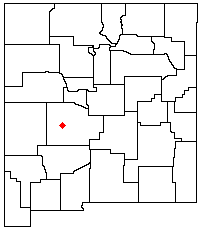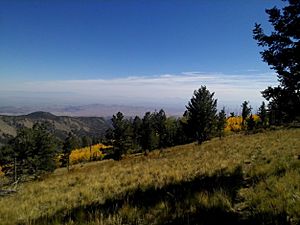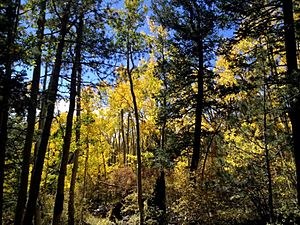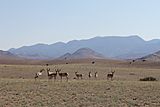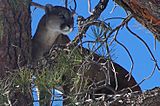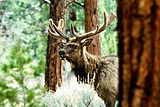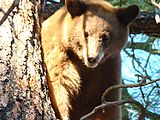Magdalena Mountains facts for kids
Quick facts for kids Magdalena Mountains |
|
|---|---|

The view looking southwest at Sawmill Canyon, near the Langmuir Research Site in the Magdalena Mountains.
|
|
| Highest point | |
| Peak | South Baldy |
| Elevation | 10,783 ft (3,287 m) |
| Dimensions | |
| Length | 18 mi (29 km) North-South |
| Geography | |
| Country | United States |
| State | New Mexico |
The Magdalena Mountains are a tall mountain range in Socorro County, located in west-central New Mexico, United States. The highest point in the range is South Baldy, which stands at 10,783 feet (3,287 meters). This makes it the tallest peak in all of Socorro County!
The range runs mostly north to south and is about 18 miles (28 km) long. It's found just south of the village of Magdalena and about 18 miles (28 km) west of Socorro. The Magdalena Mountains are a special type of mountain range called a fault-block range. This means they were formed when large blocks of the Earth's crust moved along cracks (faults).
The mountains get their name from a volcanic peak on their west side, called Magdalena Peak. This peak was named after Mary Magdalene. If you look closely at the east side of Magdalena Peak, you might see a rock formation and some shrubs that look like a woman's face! One old story says that the face of Mary Magdalene appeared there, scaring away a group of Apache warriors who were attacking some Mexicans on the mountain.
Contents
Managing the Mountains
Most of the Magdalena Mountains are part of the Magdalena Ranger District, which is managed by the Cibola National Forest. Other parts are looked after by the Bureau of Land Management. These groups help protect the natural beauty and wildlife of the area.
Even though there aren't specific "Wilderness areas" here, a large part of the mountains, called the Ryan Hill Inventoried Roadless Area, is kept wild. This area is about 35,000 acres big! In 1980, a special law was passed to create the Langmuir Research Site in the Magdalena Mountains. This site is perfect for studying the atmosphere and stars. Scientists have been working at the Langmuir Laboratory near South Baldy since the mid-1960s.
Fun Activities in the Mountains
The Magdalena Mountains have many trails, perfect for outdoor adventures! You can go hiking, backpacking, hunting, or horseback riding. It's also a great place for stargazing because there's not much light pollution.
The Forest Service says there are over 60 miles of trails in the Magdalenas. More than half of these trails are in the wild Ryan Hill Inventoried Roadless Area.
If you want to camp, there's a developed campsite called Water Canyon Campground. It's located at 6,800 feet elevation in the mountains.
Here are some of the important peaks in the Magdalena Mountains:
| Mountain | Height (feet) | Height (meters) | Coordinates | Prominence (feet) |
|---|---|---|---|---|
| South Baldy | 10,783 | 3,287 | 33°59′29″N 107°11′17″W / 33.9913°N 107.1880°W | 3,813 |
| Timber Peak | 10,510 | 3,203 | 33°58′44″N 107°09′37″W / 33.9790°N 107.1603°W | 650 |
| North Baldy | 9,858 | 3,005 | 34°03′01″N 107°10′53″W / 34.0503°N 107.1813°W | 554 |
| Buck Peak | 9,085 | 2,769 | 33°58′58″N 107°07′51″W / 33.9827°N 107.1307°W | 625 |
Scientific Research
At the southern end of the main mountain range, near South Baldy, you'll find the Langmuir Laboratory for Atmospheric Research. This lab is part of the New Mexico Institute of Mining and Technology (New Mexico Tech). The Magdalena Mountains were chosen for this lab because thunderstorms often start there. These storms are usually isolated, stay in one place, and are not too big, which makes them perfect for studying.
Scientists at Langmuir also study animals like bats, hummingbirds, and butterflies. They also research the different plants that grow in the area. The same area is home to the Magdalena Ridge Observatory Interferometer. This is a special telescope system also run by New Mexico Tech and other groups.
Mountain History
The history of the Magdalena Mountains is closely connected to the history of the land around them. Evidence shows that people have lived in this area for about 14,000 years! Early people, known as Paleoindians, lived here and hunted large animals.
For a long time, parts of what is now the Magdalena Ranger District were controlled by different groups of Apache people. They managed the Magdalena-Datil region from the 1600s until the late 1800s, when they were defeated in conflicts.
After these conflicts, people rushed to the mountains to mine for gold, silver, and copper. While miners searched for valuable minerals, ranchers drove thousands of sheep and cattle to stockyards in the village of Magdalena. This village was connected by train to Socorro.
The last regularly used cattle trail in the United States was actually in this area! It stretched 125 miles west from Magdalena. Cowboys and cattlemen called it the Beefsteak Trail. It was used from 1865, with its busiest time in 1919. The trail was used until trucks became common for transporting animals, and it officially closed in 1971.
Plants and Animals
The Magdalena Mountains have many different types of plants. You can find scrubland, forests of pinyon and juniper trees, ponderosa pine forests, and spruce-fir forests. There are also grasslands and areas along rivers and streams.
At lower elevations, you'll see grasses like black grama and sideoats grama. Higher up, there are blue grama and Arizona fescue. Shrubs like yucca, Apache plume, and mountain mahogany grow among the grasses.
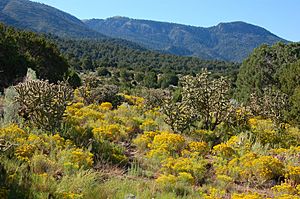
Because there are so many different habitats, the mountains are home to a wide variety of wildlife. You might see mountain lions, black bears, pronghorns, mule deer, coyotes, and foxes. Many birds live here too, including bald eagles, golden eagles, and prairie falcons.
The mountains are also very important for the Mexican spotted owl, which is a threatened species. The Magdalenas provide a safe home and a travel path for mountain lions. The Nature Conservancy has identified the Magdalena Mountains as a key area for conservation. This is because they have many different ecosystems and a rich variety of species.
- Wildlife in the Magdalena Mountains
Images for kids
See also
 In Spanish: Sierra de Magdalena para niños
In Spanish: Sierra de Magdalena para niños


